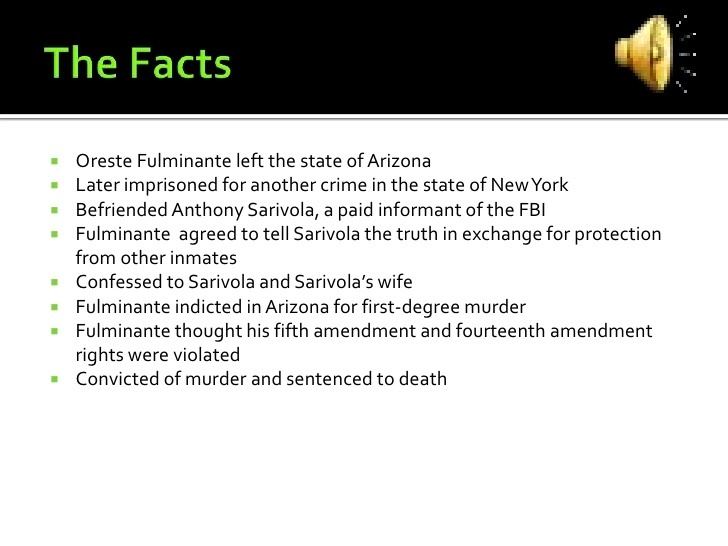Full case name Arizona v. Fulminante End date 1991 | Citations 499 U.S. 279 (more) | |
 | ||
Prior history 161 Ariz. 237, 778 P.2d 602 Majority White (Parts I, II, IV), joined by Marshall, Blackmun, Stevens; Scalia (Parts I, II); Kennedy (Parts I, IV) Concurrence Kennedy (in the judgment) Similar Dickerson v United States, Escobedo v Illinois, California v Acevedo, Florida v Bostick, Weeks v United States | ||
Arizona v. Fulminante, 499 U.S. 279 (1991), was a United States Supreme Court case clarifying the standard of review of a criminal defendant's allegedly coerced confession.
Contents
Facts
In 1982, Jeneane Michelle Hunt, the 11-year-old stepdaughter of Oreste Fulminante was murdered in Arizona. Later, Fulminante was incarcerated for an unrelated crime. While in prison, Fulminante met Anthony Sarivola, a fellow inmate, who was also a confidential informant for the Federal Bureau of Investigation. Sarivola offered Fulminante protection from "tough treatment" in prison in exchange for a confession to the murder of Fulminante's stepdaughter. Fulminante agreed, confessing to Sarivola that he murdered his stepdaughter. As a result, Fulminante was charged with the murder, and his confession to Sarivola was used against him at trial.
The trial court denied Fulminante's motion to suppress the confession on the basis that it was coerced because Fulminante might have been subject to violence in prison had he not confessed. Fulminante was convicted and was sentenced to death. He appealed to the Arizona Supreme Court, which held that the confession was indeed coerced. Reasoning that a harmless error analysis was inappropriate in the case of involuntary confessions, the court ordered a new trial.
Opinion of the Court
In an unusual occasion where two Justices each produced a partial majority opinion, the Court affirmed the Arizona Supreme Court's conclusion that the threat of violence aimed at Fulminante was credible enough to establish a finding of coercion, upholding the reversal of Fulminante's conviction. The Court held that a harmless error analysis should be applied to any allegedly coerced confession; here, the Court found that a new trial was warranted.
Justice White authored an opinion, of which Parts I, II and IV constituted a majority of the Court. Justice White found that the lower court had properly applied the "totality of the circumstances" test in the coercion context as in Schneckloth v. Bustamonte (1973) and, given that the other majority opinion of the Court had found that a coerced confession invokes harmless error analysis, that the state had not proven beyond a reasonable doubt that Fulminante's forced confession was harmless.
Chief Justice Rehnquist also delivered an opinion, of which Part II constituted a majority of the Court. Chief Justice Rehnquist wrote in this portion of his opinion that the harmless error rule adopted in Chapman v. California (1967) applied to coerced confessions, and reviewed other precedent in developing the rule.
In popular culture
Interpretation of the Fulminante decision is a major plot element in the Law & Order episode Confession.
